They WILL choose someone else for better deals, better experience, and better engagement.
What is the solution? Generational marketing.
When the pandemic struck the world, there was a considerable shift in consumer behavior. This shift forced the digitization of brands. The ones who got it right survived, while those who didn’t had to shut down their businesses. We saw some huge names struggling to keep themselves afloat. And when companies started figuring their way online, there was a drastic shift in the way products and services had to be sold to users, and personalization took the front seat when it came to running effective marketing campaigns.
Here is how the pandemic affected the three crucial marketing sectors:
- The business end: Offline businesses were forced to make a significant shift in digitization. The principal cause behind this was the drastically changing user behavior, preferences, and inclination toward digital services. This triggered businesses to adopt online retailing at a rapid pace.
- The tech end: Science and technology saw a very steep increase in use, with increased online shopping, robotic delivery systems, the introduction of advanced digital avenues like contactless payment systems, remote working, the role of technology in distance learning, telehealth, 3D printing, and online entertainment led to skyrocketing of technology in the new normal.
- The customer end: Due to the said rapid onslaught of technological advancements, there was very little time given to our customers to adapt amid the race of trying to stay ahead of the competitors.
Hence there was a need to keep evolving, to accommodate and engage new users and new technologies, and at the same time, continue trying not to spam users and burden them with unnecessary technological advancements.
This blog talks about how generational marketing is the next big thing with regard to personalization, retention, and how it is the future of customer segmentation.
- Why Is Digitization Important?
- How to create a successful Retention Campaign?
- What is Generational Marketing?
- Designing the perfect generational marketing strategy
- Multi-generational marketing
- Conclusion
Why Is Digitization Important?
Your ICP (ideal customer profile) WILL (and this isn’t even up for debate), as mentioned above, choose your competitor the second they find something that suits their needs better.
Here are some reasons, broken down by generation, for why your ICP will choose your competitor over you:
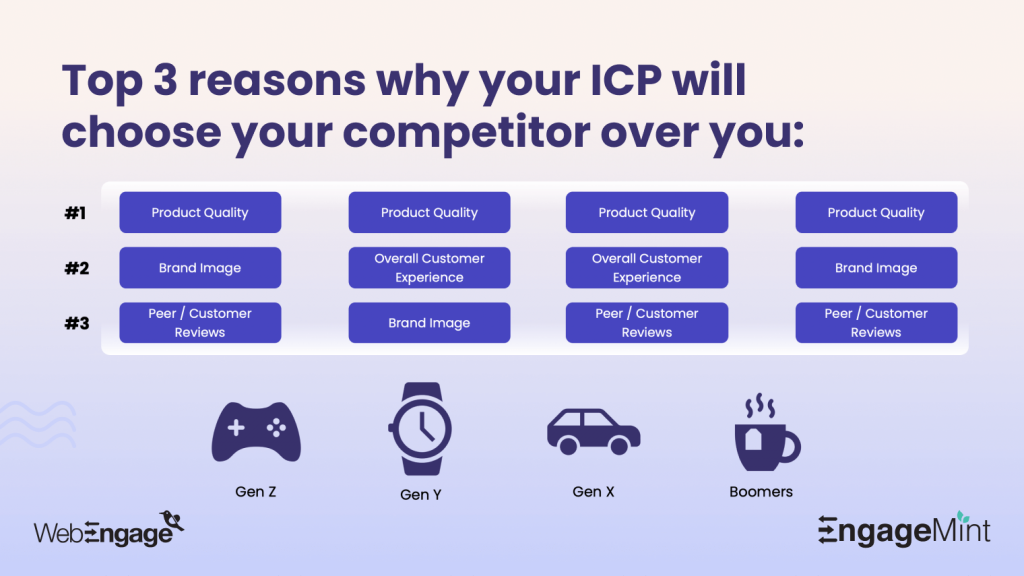
Digitization and retention are closely related in the world of marketing campaigns. Digitization drives patient loyalty and retention through convenience. Needless to say, the more convenience a brand gives its end users, the more they’re bound to go towards them—bad technology and poor experiences lower retention rates like nothing else.
Retention also aids in win-back campaigns, personalizing a user’s overall brand experience, and contributes to your overall ROI. So here’s how you make sure your retention campaigns are successful.
How to create a Successful Retention Campaign?
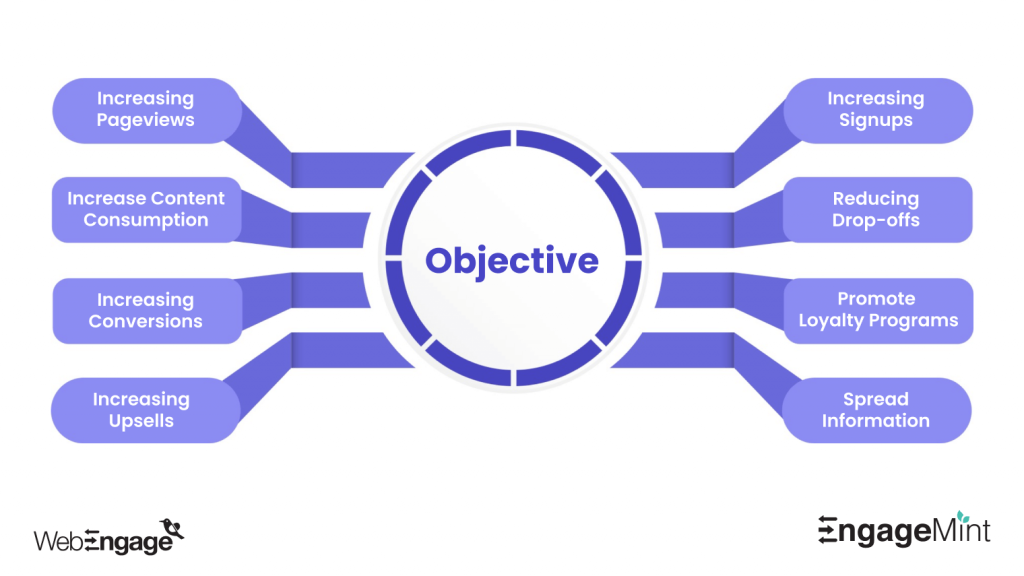
Designing a successful retention marketing campaign starts by answering:
- Why are you running this campaign? / what is your objective?
- Whom are you going to target with this campaign?
- What is your communication strategy?
- How will you connect with your audience? (tone, voice/language, content, etc.)
- How would you measure the success of your campaign?
It’s a no-brainer that businesses today have to outdo their competitors in order to stand out as the hero. With every brand promising 10-minute deliveries, consumers will applaud the one that serves them in 5. Hence, keeping ourselves upgraded and on top of our game is imperative in a competitive market.
The starting point to that is to create a behavioral campaign successfully. How do you do that? Simple, through carefully crafted user segmentation.
Investopedia calls segmentation the process of ‘aggregating prospective buyers into groups with common needs and who respond similarly to a marketing action.’
How does segmentation help reach the right audience for your business?
- Better understand your audience
- Run more targeted campaigns
- Customize content
- Identify demand and supply patterns
- Utilize time & resources efficiently
- Design better products/tweak designs according to user’s needs
But who are you targeting to retain?
There are three very obvious personas for any product-based segment – Viewers, Buyers, and Danglers. People who view products, compare and drop off, people who buy said products, and people who add products to cart or wishlist them but abandon the conversion journey mid-way.
Here are a few popular and known ways of segmenting your audience that have worked quite well for several iconic campaigns in the past few years for a marketer.
A traditional approach to segmentation (demographic):
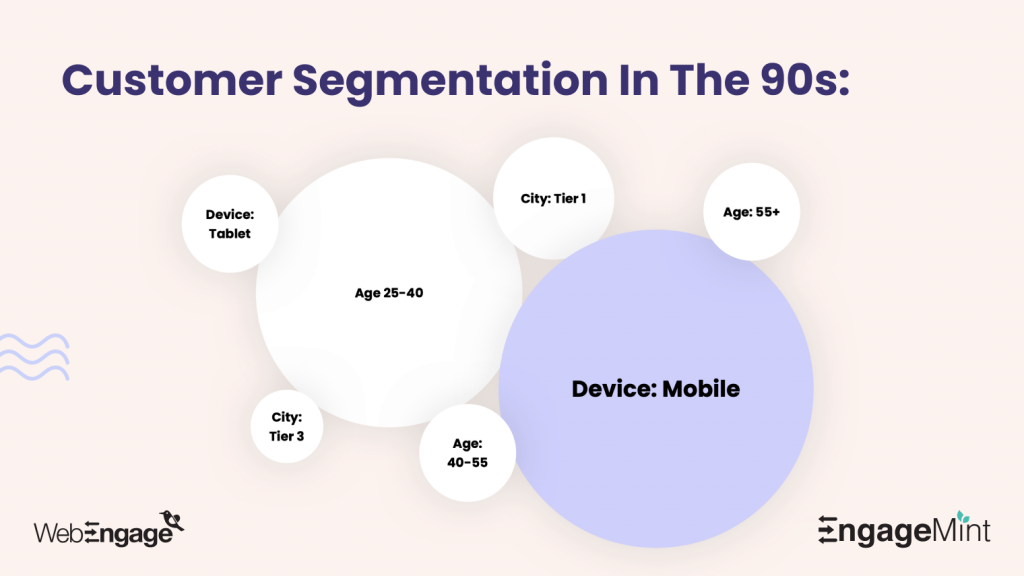
Zomato & Swiggy – demographic: Geographic Location
They send out one notification to a few thousand users at a time, around breakfast, lunch, snack, and dinner times.
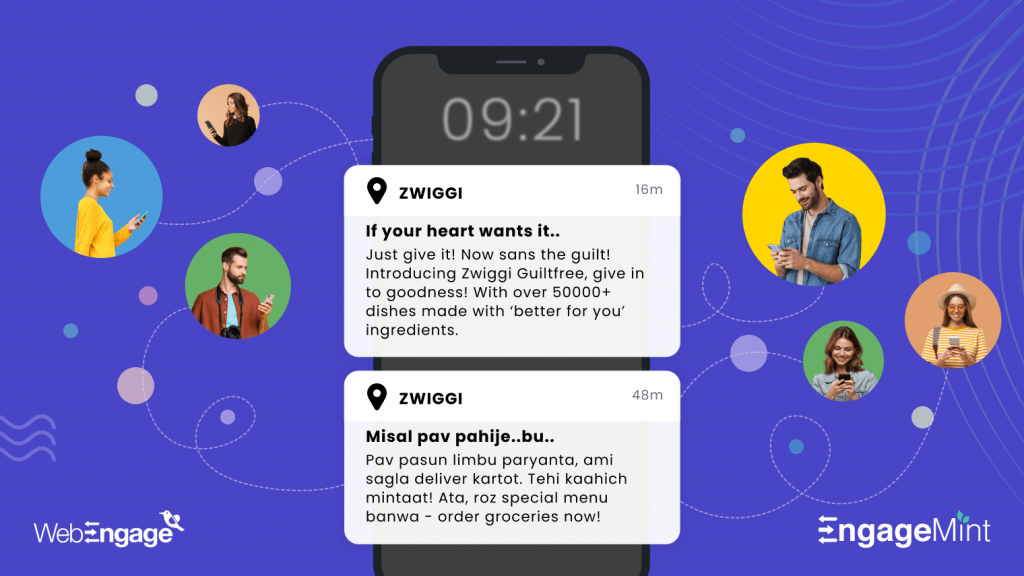
Victoria’s Secret, Savage X Fenty, Enamour – demographic: Gender
They target women specifically for their products. A demographic of men may not profit the business as much as women might.
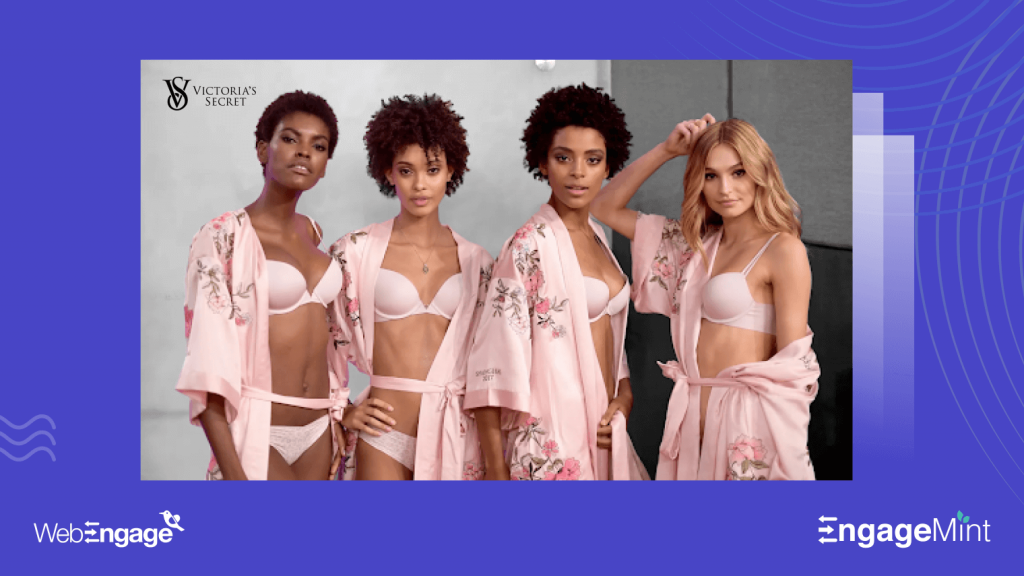
Why it fails:
The category of demographic segmentation fails to meet a very particular aspect, one that furthers a marketing campaign: The product remains the same, the category/segment remains the same, but every user will have a different need. In fact, the broad category of all users isn’t even considered with demographic segmentation.
For instance, males vs. females, single vs. married, employed vs. unemployed.
An unemployed person may not consider ordering from Zomato/Swiggy and would try to cook their own meals.
Another aspect is that you need to assume many of the criteria required to run a successful ad campaign simply based on one part of the demographic.
Furthermore, and on the other hand, simply considering only one generic category of your audience drastically reduces the campaign’s overall effectiveness.
Not all women might want to buy from Victoria’s Secret, not all sportspeople will be able to afford Nike’s sneakers, and not all users might order that cool chicken biryani because they’re vegetarians.
And last but not least, there are very few elements of personalization you can use.
A semi-modern approach to segmentation (behavioral)
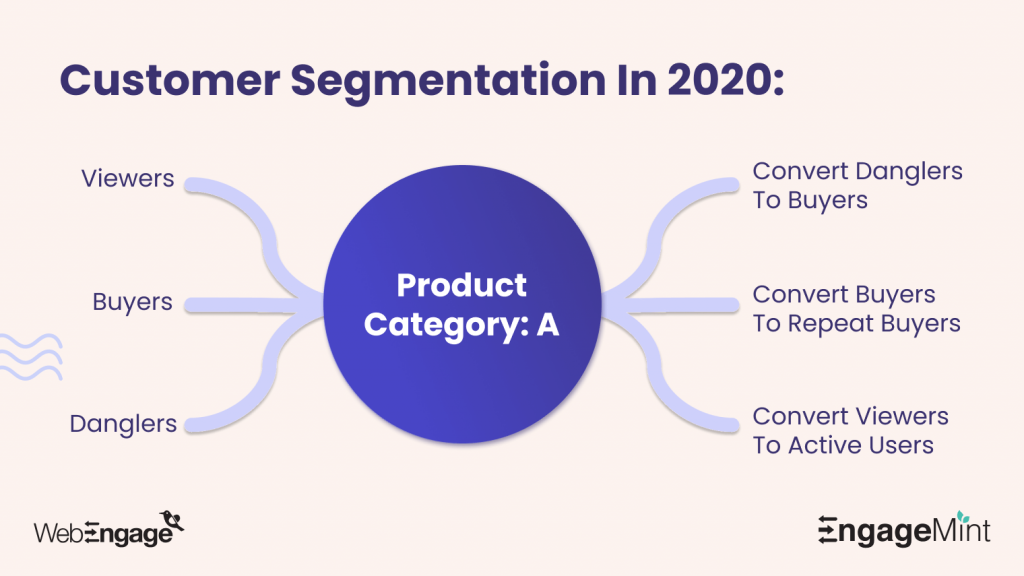
This is the most popular method of segmentation in a marketer’s kit.
User events and their behavioral data are what constitute most marketing campaigns today.
Has your customer left something in their cart? Target them so. Have they left something during their checkout process? Market a campaign around that. Have they not updated their app to the latest version? That’s your cue.
These are some of the most common user behaviors targeted across most campaigns.
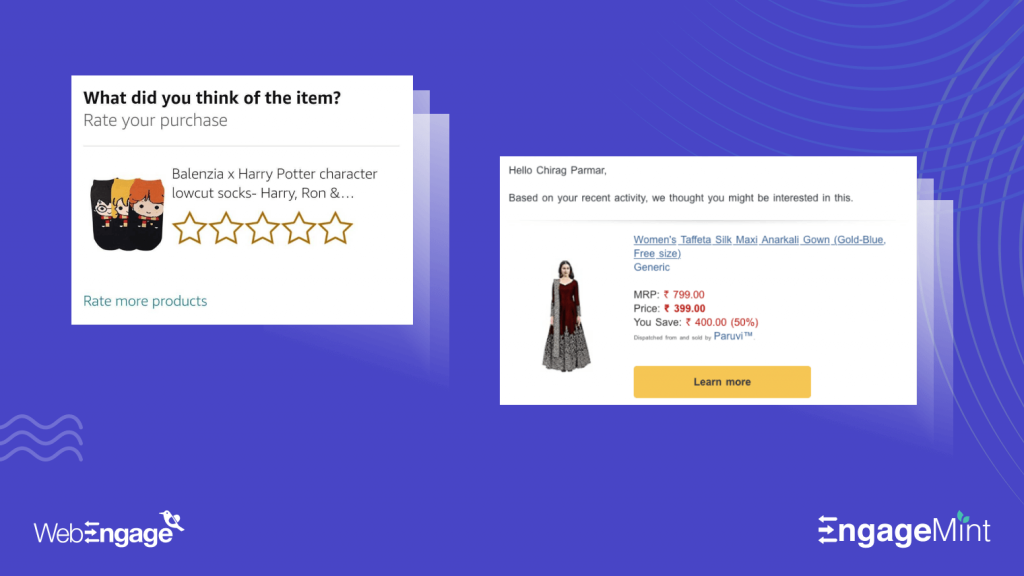
Why it fails:
When one talks about behavioral segmentation, one fails to understand that these behaviors, commonly referred to as ‘events,’ are only targeted AFTER said event has taken place. It might forget to tell you WHY a specific event is triggered, and the motivation behind it, etc., isn’t considered before running the campaign.
For instance, your user might have expressed interest in a specific product or service, but that doesn’t entail that they will be interested in ALL kinds of that product/service. They might open one type of email newsletter, but will they open all newsletters?
Behavioral segmentation today relies on generic information that we get through analysis of earlier campaigns and industry trends when considering buying patterns.
It is also heavily reliant on marketers interpreting the data correctly and understanding/being empathetic to customers’ thought processes and decision-making processes. And lastly, it cannot be measured. Human behavior is erratic, dynamic, and can’t be put into a fixed set of numbers every time.
Future of customer segmentation (generational)
Here comes the one thing that will help you navigate the segmentation and personalization maze. And one that will keep you upgraded and to the best of your game in a competitive market.
What is Generational Marketing?
Generational marketing and segmentation add the perfect layer to further break down the behavioral segmentation pie you saw above for ease of access and aiding analytics.
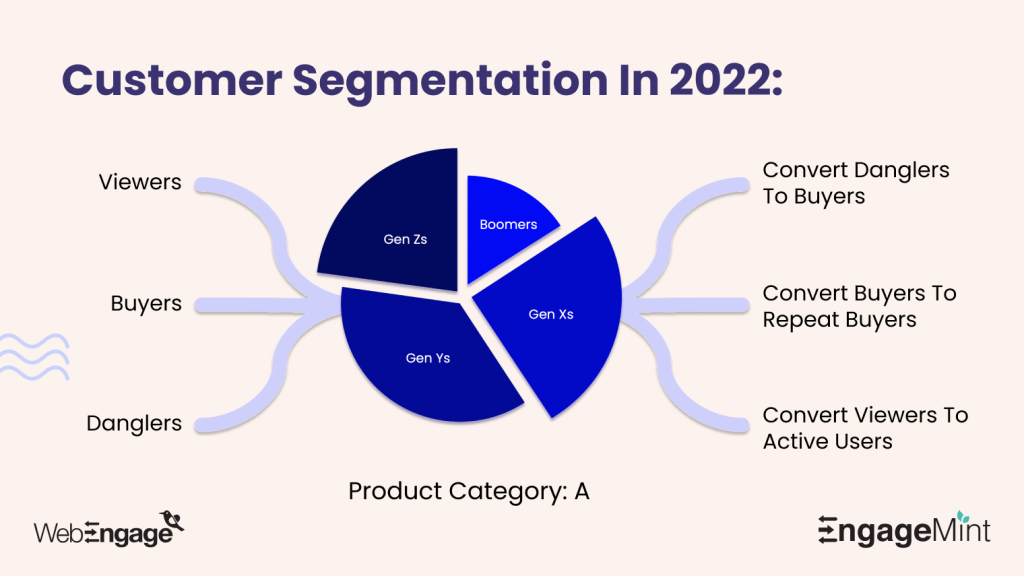
By definition, generational marketing refers to marketing to different generations, seeing what makes them tick, their attributes and upbringings, that have influencing powers over their buying habits.
It allows marketers to group and target an audience based on similarities and dissimilarities. Understanding each generation and their preferences are vital for the success of generational marketing.
Defining the Generations*
(AS OF 2022*)
1. Boomers: Ages 57 and above
Boomers are conservative and altruistic and become less materialistic as they age. They’ve seen an age when marketing was simply a billboard and a newspaper. They’ve also lived through the nation JUST gaining independence. For them, essential services would probably be nursing or retirement homes and assisted-living services, targetted through print media.
How to market to them:
Social media channels of choice: Traditional social media – Facebook, WhatsApp
Most responsive to: Handheld advertising, simple, spoonfed information
Trusted brands for generation: Brands that have been around for a few decades
Baby boomers are apprehensive. They usually turn out to be hoarders and value their security and rationing a lot since they’ve seen days that have been consumed with wars and riots. They’re also the ones who would be seen shopping in person, in the store, even in 2022. They will adore and respect consistency and are usually brand-loyal shoppers but still try to one-up Gen Z.
They have the money and the time to spend on things they like. They are now looking for asset distribution. They rely on tried and trusted things and will work well with Facebook and WhatsApp, which, according to the newer generation, is ineffective and old but is a sure-shot way of getting to said age range because of their urge to learn everything new and keep up with the trends. The best way to appeal to them is through coupons, special offers, and email marketing campaigns.
2. Gen X: 1965 – 1980 | Ages 57 to 42
These are our parents. The know-it-alls, the we-had-to-fight-crocodiles-to-go-to-school ones, and the ‘hume mat sikhao, hum behtar jaante hai’ ones.
They’ve seen the emergency, heard of the pre-independence life, and seen and grown through the advent of the internet. Here is where you can take full advantage of brand loyalty.
How to market to them:
Social media channels of choice: WhatsApp, Google Ads, Email, Linkedin
Most responsive to: Word of Mouth, Email Marketing
Trusted brands for generation: Brands that have an offline presence
Gen X began with seeing computers happen to the world of marketing in real-time. They are the professionals, the ‘work is everything’ lecturers, the ones who will, unfortunately, fall for phishing scams, and the ones who will believe their relatives’ and peers’ opinions for products & services. They’re materialistic and impatient, in most cases, because they had to deal with the ever-increasing speed of the internet (figuratively and literally) and still struggle with coping in 2022.
This means that they’re also less trusting and cautious of marketing campaigns.
The best way to reach out to them, as their previous generation, would be Facebook and WhatsApp, along with Google Ads, targeted email campaigns, push notifications, and LinkedIn, for the tech-savvy.
They will also respond well to actors/music/things that remind them of their childhood, so that’s one tactic to look out for.
3. Gen Y: 1981 – 1996 | Ages 41 to 26
The big generation. The first generation that grew up without cellphones and with the internet, all within ten years. They’re considered the most significant demographic not only in India but also in the whole world. This provides a marketer a splendid opportunity to build a varied customer base and effectively tweak and cater campaigns.
How to market to them:
Social media channels of choice: Push Notifications, Emails, SMS, WhatsApp, Facebook, Instagram, Snapchat, Twitter, Pinterest (basically, everything)
Most responsive to: Reviews, Blogs, Word Of Mouth
Trusted brands for generation: Brands that give them a social acceptance
Marketing to Gen Y would be considered easy and challenging at the same time.
Easy because they’re figuratively easier to reach out to, difficult because within Gen Y, there are several kinds of audiences to target. And having grown up in the age of technology, they’re used to having given a wide array of opportunities and varieties for every product and service.
The Millenials prefer user-generated content as opposed to hardcore marketing campaigns. Word of mouth is a sure-shot way of working with them, and there’s nothing out of their reach with social media at the fore. However, they’re less bound to be brand loyal, picking your competitors over you at the first sign of a better experience and price. So the best way to go about marketing to them would be to choose your targets well.
They invented the concept of FOMO, memes, and edutech, so why not target them using the same?
4. Gen Z: 1997 – 2012 | Ages 25 to 10
The most notorious generation.
Gen Z is usually the most picked upon generation since they’ve been on the receiving end of their previous generations’ best and worst.
Spoonfed technology that they’re excelling at every day, diversity like none of their counterparts, and witnessing the worst infraction and economic disparity rates across the globe, they’re living it all in real-time. Mobile phones are primarily used by the young (Gen Y and Z) in India, and 50% of the nation’s population is under 25 years of age.
How to market to them:
Social media channels of choice: Push Notifications, everything Social Media
Most responsive to: Video, influencers
Trusted brands for generation: Brands that give them a sense of community
They’re reliant on reviews, reviews, and more reviews. They’re the most well-researched generation and will make sure they do their bit before spending on any product or service.
How do you market to them?
Engage.
Light fun, some degree of a viral quotient, community-oriented messaging, and you should be quick to catch their eye.
They’re most likely to turn back to look at brands that have good engagement strategies and plans. With Gen Z, staying on top of trends, increasing shareability, and overall good moral values are a sure sell.
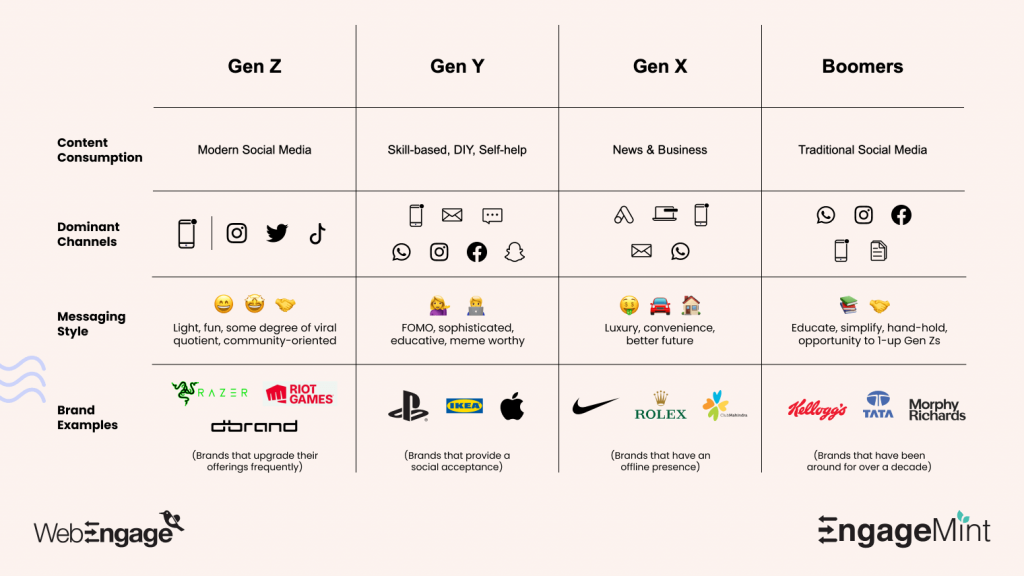
So, in an ideal marketing campaign, your personalization process should look something like:
Why is this important?
We’ll tell you.
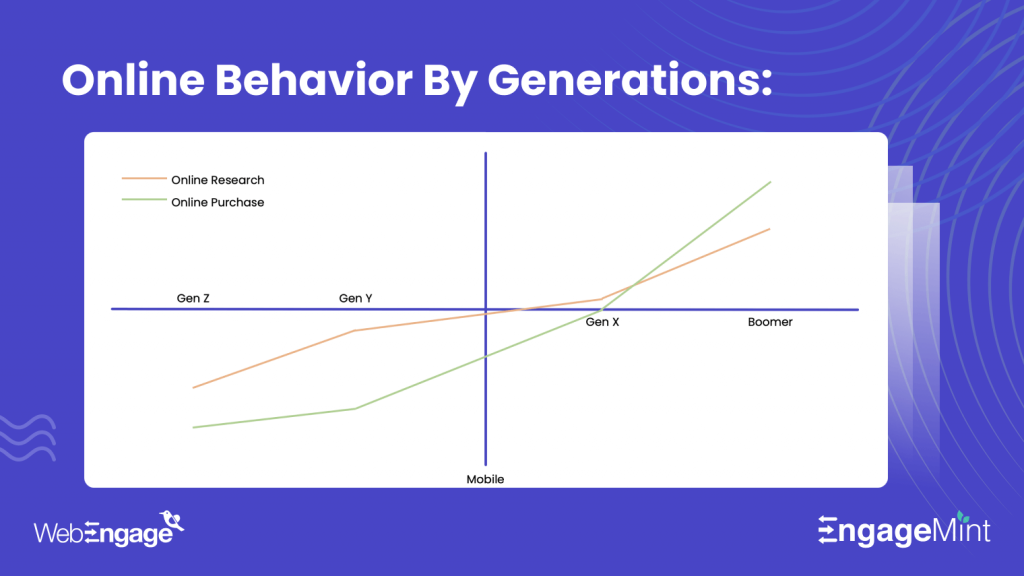
As you can see in the graph above, online research vs. online purchase shows a stark difference as you go up the generation gap.
Also, the device of choice matters.
So now that we’ve established segmentation, their drawbacks, age ranges, their marketing tactics, how to reach out to them, and the device of choice, how do you go about making the perfect generational marketing strategy? (Also, the reason why you’ve been reading this so far)
Let’s have a look.
Designing the perfect generational marketing strategy
WebEngage recently published our flagship engagement trends report spanning five key geographies and ten industries and found out that a personalized and contextual campaign can give you over 500% growth in conversions over blast promotional campaign.
Here is what a good engagement strategy would look like across generations:
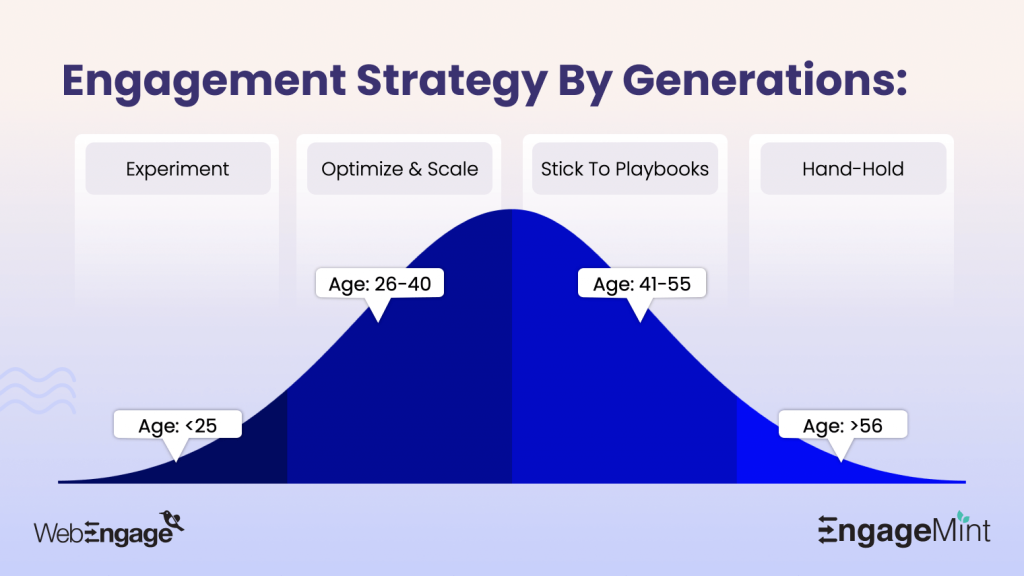
With Gen Z, you would want to take the experimental track.
You can cut, paste, tweak and merge your campaigns and strategies as you like because there is plenty of room to play and figure out what exactly works for your brand. Also, they have the maximum influence over the Boomers, so you might also want to consider that aspect. Give them an intelligent deal (since they tend to have the least spending capacity), and they’re yours.
With Gen Y, you need to optimize and scale.
Millennials love and root for the next big thing, so the best way to approach them would be to go for good reviews and social approvals. They are reshaping how goods and services are being marketed by staying unresponsive to traditional marketing tactics. Have a conversation with any Millenial, and you will find out that they won’t make a significant decision until they have discussed it with people they trust — everything from what neighborhood to live in, to where to go on a first date or more about starting a business.
Gen X is your go-to generation when you want to stick to the playbooks.
Traditional methods & tried and tested variants are what will make your brand? Make Gen X your bestie. Subscriptions, loyalty cards, reward programs, coupons for multiple sales, etc., are all that will get them to flock to your brand within no time.
And finally, Boomers need the hand-held technique.
They will constantly try to look out for ways to one-up Gen Z kids, but at the same time, they have a purchasing power that their other three counterparts lack heavily. They’ve done their schooling, working, hustle, and are set to retire, or already have.
They’re also the ones who are (seemingly) tired of the ever-evolving technologies and need the information to be spoonfed to them.
Subsequently, it becomes pretty clear where every generation’s brand loyalty lies.
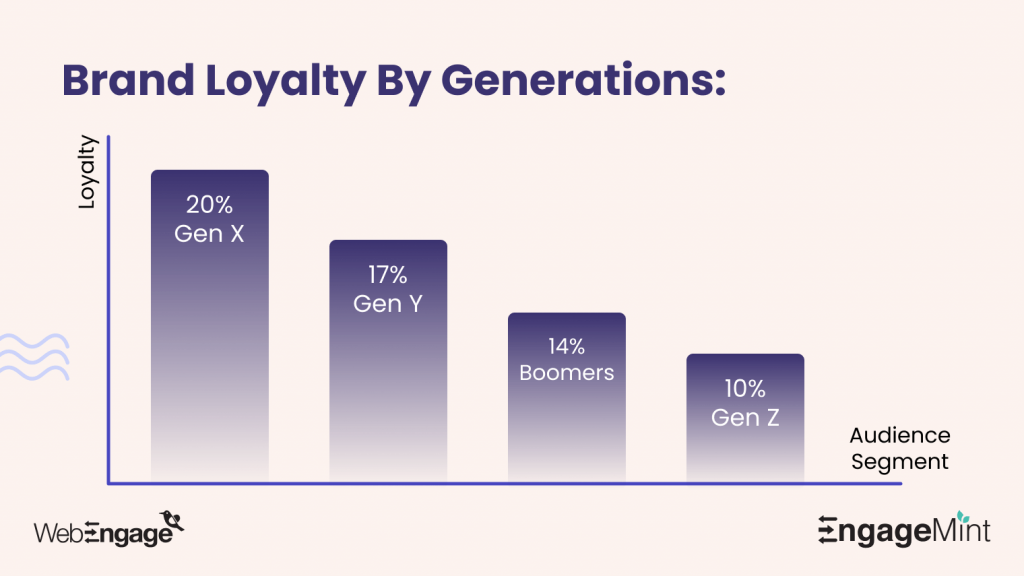
Multi-generational marketing
By definition, multi-generational marketing is the practice of appealing to the unique needs and behaviors of individuals that vary from generation to generation, with a similar marketing approach/campaign.
Multi-generational marketing essentially comprises two principles:
- A product’s needs change with life stages
- Products targeting these groups can reflect their respective generational values, driving their consumption behavior.
Marketing trends and behaviors have pointed out correctly that in the coming 20 odd years, creating ageless multigenerational brands is one of the top ten marketing trends and will be a challenge we’re all excited to see be executed.
However, it is essential to realize that ‘age’ and ‘generations’ contribute to only being one factor influencing behavior. In some cases, differences within a generation can be more significant than differences across generations.
Additionally, generations do not have sharp boundaries. Individuals near the age breaks between generations often do not belong clearly to either generation, who can make or break a particular campaign that you may have thought might work in your favor.
Conclusion
Across a generational marketing strategy, is a clear-as-day, apparent, plain, visible, and marked message saying ‘5x GROWTH IN CONVERSIONS’.

Nope, we’re not lying. Personalized and contextual campaigns can give up to 5.25x growth in conversions (India) over blast promotional campaigns (across channels). 80% of online shoppers make at least 1 in 5 purchases for others.
Now that we’ve established that, it is also essential to know that incorporating generational marketing provides a marketer with an excellent foundation to build their marketing strategies. However, one should consider it a building block to their campaigns instead of an end goal.
Of course, generational marketing isn’t meant for every business, but it helps other marketing strategies, planning, first-party data, and buyer personas.
We at WebEngage provide you with the perfect platform to segment your audience according to your needs and further compare and tweak campaigns. We bring a robust customer data platform, a personalization engine, an omnichannel campaign manager, and an analytics engine into one seamless full-stack retention OS.
Take a demo with WebEngage and add generational marketing to your customer retention strategies now!








 Diksha Dwivedi
Diksha Dwivedi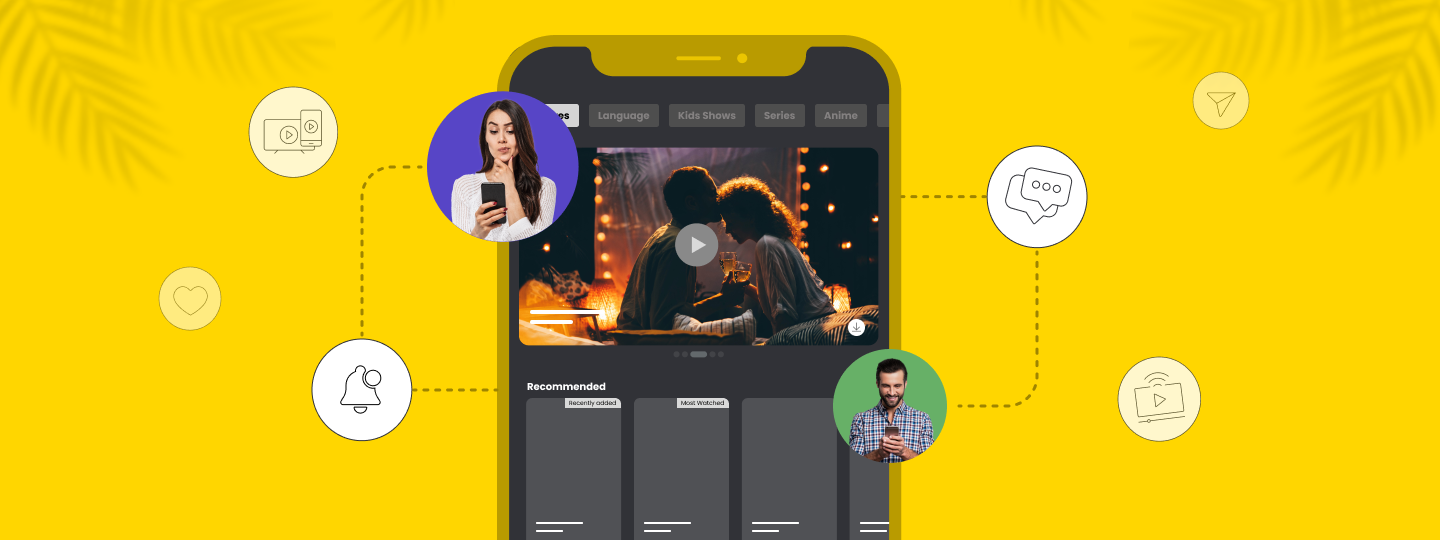
 Vanhishikha Bhargava
Vanhishikha Bhargava
 Sanjay Mishra
Sanjay Mishra